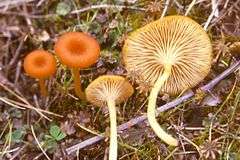Loreleia
Loreleia is a genus of brightly colored agarics in the Hymenochaetales that have an omphalinoid morphology.[1][2][3] They inhabit mosses and or liverworts on soil in temperate regions of the Northern Hemisphere.[4] Phylogenetically related agarics are in the genera Contumyces, Gyroflexus, Rickenella, Cantharellopsis and Blasiphalia, as well as the stipitate-stereoid genera Muscinupta and Cotylidia[5] and the clavaroid genus, Alloclavaria.[3] However, the large number of DNA base-pair changes causes a long-branch to form in phylogenetic analyses depicted as cladograms.
| Loreleia | |
|---|---|
 | |
| Loreleia postii | |
| Scientific classification | |
| Kingdom: | |
| Division: | |
| Class: | |
| Order: | |
| Family: | |
| Genus: | Loreleia |
| Type species | |
| Loreleia postii (Fr.) Redhead, Moncalvo, Vilgalys & Lutzoni (2002) | |
| Species | |
|
L. marchantiae | |
In the field, to the eye, Loreleia is most similar to Rickenella because of the orangish colors and omphalinoid shape, but microscopically it differs by the absence of cystidia that in Rickenella make the latter minutely fuzzy as seen with a hand lens.[6] Loreleia penetrates the rhizoids of liverworts and may form a type of symbiosis with them,[7] but in axenic culture tests, L. marchantiae killed Marchantia polymorpha when directly inoculated[8] in contrast to the absence of necrosis in nature in situ. In nature Loreleia often occur in wet areas such as seepages with their hosts, Marchantia.
Older literature often treats the species, like L. postii and L. marchantiae, in the genera Omphalina or Gerronema.
Etymology
Loreleia was named after the contemporary American mycologist, Dr. Lorelei L. Norvell, who studied omphalinoid agarics, and who apropos was in turn named after the riverine Lorelei of folklore.
References
- Redhead, S.A.; et al. (2002a). "Phylogeny of agarics: partial systematics solutions for bryophilous omphalinoid agarics outside of the Agaricales (euagarics)". Mycotaxon. 82: 151–168.
- Redhead, S.A.; et al. (2002b). "Phylogeny of agarics: partial systematics solutions for core omphalinoid genera in the Agaricales (euagarics)". Mycotaxon. 83: 19–57.
- Dentinger, B.T.M. & McLaughlin, D.J. (2006). "Reconstructing the Clavariaceae using nuclear large subunit rDNA sequences and a new genus segregated from Clavaria". Mycologia. 98 (5): 746–762. doi:10.3852/mycologia.98.5.746. PMID 17256578.
- Læssøe T, Petersen JH (2019). Fungi of Temperate Europe Vol 1. Princeton University Press. ISBN 9780691180373.
- Larsson, K.-H.; et al. (2006) [2007]. "Hymenochaetales: a molecular phylogeny for the hymenochaetoid clade". Mycologia. 98 (6): 926–936. doi:10.3852/mycologia.98.6.926. PMID 17486969.
- Norvell, L.L.; et al. (1994). "Omphalina sensu lato in North America. 1-2: 1: Omphalina wynniae and the genus Chrysomphalina. 2: Omphalina sensu Bigelow". Mycotaxon. 50: 379–407.
- Bresinsky, A. & Schötz, A. (2006). "Behaviour in cultures and habitat requirements of species within the genera Loreleia and Rickenella (Agaricales)". Acta Mycol. 41 (2): 189–208. doi:10.5586/am.2006.022.
- Kost, G. (1988). "Interactions between Basidiomycetes and Bryophyta". Endocytobiosis Cell Res. 5: 287–308.
External links
- www.nahuby.sk Image of Loreleia postii